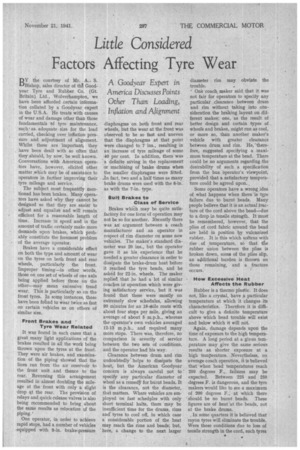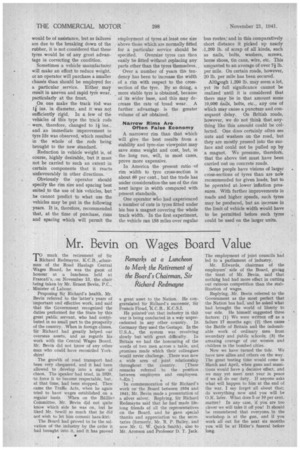Little Considered Factors Affecting Tyre Wear
Page 29

Page 30

If you've noticed an error in this article please click here to report it so we can fix it.
Bthe courtesy of Mr. A.. S. 1--/Bishop, sales director of the Goodyear Tyre and Rubber Co. (Gt. Britain) Ltd., Wolverhampton, we have been afforded certain information collated by a Goodyear expert in the U.S.A. He treats with causes of wear and damage other than those fundamentals of tyre maintenance, such' as. adequate size for the load carried, checking over inflation pressure and adjustment of alignment. Whilst these are 'important; they have been dealt with so often that they should, by now, be well known. Conversations with American opera.tors have, however, elicited other matter which may be of assistance to operators in further improving their tyre mileage and service.
The subject most frequently mentioned has been brakes Many operators have asked why they cannot be designed so that they are easier to adjust and equalize and will remain efficient for a reasonable length of time. Increase in speed and in the amount of traffic certainly make more demands upon brakes, which probably constitute the foremost problem of the average operator.
Brakes have a considerable effect on both the type and amount of wear on the tyres on both front and rear wheels, particularly the front. Improper timing—in other words, those on one set of wheels of one axle being applied before those on the other—may mean excessive tread wear. This is particularly so on the front tyres. In some instances, these have been folind to Wear twice as fast on certain vehicles as on others of similar size.
Front Brakes and Tyre Wear Related
It was found in such cases that a great many light applications of the brakes resulted in all the work being thrown upon the tyres at the front. They were air brakes, and examination of the piping showed that the lines ran from the air reservoir to the front unit and thence to the rear. Reversing this arrangement resulted in almost doubling the mileage at the front with only a slight drop at the rear. The provision of relays and quick-release valves is also being recommended to bring about the same results as relocation of the piping.'
One operator, in order to achieve rapid stops, had a number of vehicles equipped with 8-in. brake-pressure diaphragms on both front and rear wheels, but the wear at the front was observed to be so fast and uneven that the diaphragms at that point were changed to 7 ins., resulting in an increase of tyre mileage of some 40 per cent. In addition, there was a definite saving in the replacement or machining of biake drums when the smaller diaphragms were fitted. -In fact, two and a half times as many brake drums were used with the 8-in. as with the 7-in. type.
Suit Brakes to Class of Service
Brakes whiCh may be quite satisfactory for one form of operation may not be so for another. Recently there was an argument between a coach manufacturer and an operator in respect of rim diameter on some new vehicles. The maker's standard diameter was 20 ins., but the operator gave it as his experience that he needed a greater clearance in order to dissipate the brake-drum heat before it reached the tyre beads, and he asked for 22-in. wheels. The maker replied that he had a lot of similar coaches in operation which were giving satisfactory service, but it was found that these were mostly on extremely slow schedules, allowing 90 minutes for an )8-mile route with about four stops per mile, giving an average of about 5 m.p.h., whereas the operator's own vehicles averaged 12-13 m.p.h., and required many more stops. There was, therefore, no comparison in severity of service between the two sets of conditions, and the operator had his way.
Clearance between drum and rim undoubtedly' helps to dissipate the heat, but the American Goodyear concern is always careful not to specify any particular diameter of wheel as a remedy for burnt beads. It is the clearance, not the diameter, that matters. Where vehicles are employed on fast schedules with only short terminal halts, there may be insufficient time for the drums, rims and tyres to cool off, in which case a considerable portion of the heat may reach the rims and beads; but, here, a change to the next larger diameter rim may obviate the trouble.
' One coach, maker said that it was not fair for operators to specify any particular clearance between drum and rim without taking into consideration the braking layout on different makes; one, as the result of better design and certain types of wheels and brakes, might run as cool, or more so, than another maker's vehicle with greater clearance between drum and rim. He:therefore, suggested specifying a maxi' mum temperature at the bead. There could be no arguments regarding the desirability of such a specification from the bus operator's viewpoint, provided that a satisfactory temperature could be agreed upon.,
Some operators have a wrong idea of what happens when there -is tyre failure due to burnt beads. Many people believe that it is an actual fracture of the cord above the bead—due to a drop in tensile strength. It must be remembered, however, that the plies of cord fabric around the bead are held in position 1.ay vulcanized rubber. It is this which softens with rise of temperature, so that tfie rubber union between the plies is broken down, some of the plies slip, an additional burden is thrown on those remaining, and a fracture occurs.
How Excessive Heat Affects the Rubber
Rubber is a thermo plastic. It does not, like a crystal, have a particular temperature at which it changes its characteristics. Therefore it is difficult to give a definite temperature above which bead trouble will exist and below which it will not.
Again, damage depends upon the time of exposure to the high temperature. A long period at a given temperature may give the same serious results as shorter exposure at a high temperature. Nevertheless, on average coach operation, it is believed that when bead temperatures reach 250 degrees F., failures may be expected. Between 225 and 250 degrees F. is dangerous, and the tyre makers would like to see a maximum of 200 degrees F., at which there should be no burnt beads. These figures are of heat at the beads, not at the brake drums.
In some quarters it is believed that rayon tyres will eliminate the trouble. Were these conditions due to loss of tensile strength in the cord, such tyres would be of assistance, but as failures are due to the breaking down of the rubber, it is not considered that these tyres would be of any great advantage in correcting the condition.
Sometimes a vehicle manufacturer will make an effort to reduce weight, or an operator will purchase a smaller chassis than should be employed for . a particular service. Either may result in uneven and rapid tyre wear, particularly at the front.
On one make the track rod was le ins, in diameter, and it was not sufficiently rigid. In a few of the vehicles of this type the track rods were, therefore, changed to le ins., and an immediate improvement in tyre life was observed, which resulted in the whole of the rods being brought to the new standard.
Reduction in vehicle weight is, of course, highly desirable, but it must not be carried to such an extent in certain components that it reacts unfavourably in other directions.
Obviously the operator should specify the rim size and spacing best suited to the use of his vehicles, but he cannot predict to what use the vehicles may be put in the following -years. It is, therefore, recommended that, at the time of purchase, rims and spacing which will permit the employment of tyres at least one size above those which are normally fitted for a particular service should be specified. Oversize tyres can then easily be fitted without replacing any parts other than the tyres themselves., Over a number of years the tendency has been to increase the width of a rim with respect to the crosssection of the tyre. By so doing, a more stable tyre is obtained, because of its .wider base, and this may decrease the rate of tread wear, A further advantage is the greater volume of air obtained.
Narrow Rims Are Often False Economy A narrower rim than that which will give the best results from a stability and tyre-size viewpoint may save some weight and cost, but, in the long run, will, in most cases, prove more expensive, In America the present ratio -of rim width to tyre cross-section is about 60 per cent,, but the trade has under consideration the use of the rim next larger in width compared with present standards.
. One operator wim had experienced a number of cuts in tyres fitted under his bus b magnet covering the whole track width. In the first experiment, the vehicle ran 158 miles over regular
bus routes: and in this comparatively short distance it picked up nearly 1,200 lb. of scrap of all kinds, such as nails, bolts, washers, screws, horse shoes, tin cans, wire, etc. This amounted to an average of over 71 lb. per mile. On certain roads, however, 20 lb. per mile has been secured.
Altb,pugh 1,200 lb. may seem a lot, yet its full significance cannot be realized until it is considered that there may be in that amount some 10,000 nails, bolts, etc., any one of which may cause a puncture and consequent delay. On British roads, however, we do not think that anything like this amount could be collected_ One does certainly often see nuts and washers on the road, but they are mostly :pressed into the surface and could not be pulled up by a magnet. We presume, therefofe, that the above test must have been carried out on concrete roads.
Some people have visions of larger cross-sections of tyres than are • now recommended for given loads, but to be operated at lower inflation pressures. With further improvements in roads and higher speeds, such tyres may be produced, but an increase in the limit of vehicle width would have to be permitted before such tyres could be used on the larger units.




















































